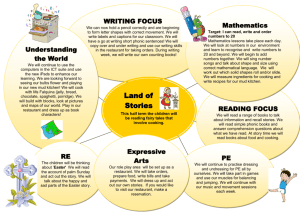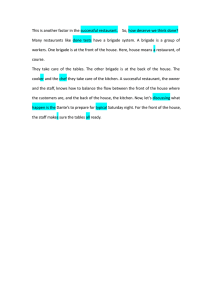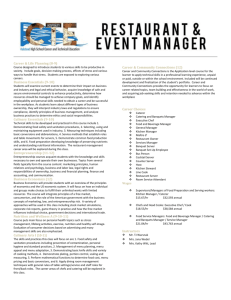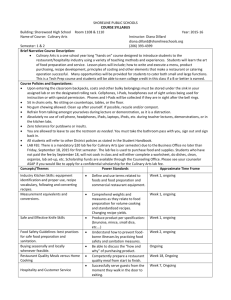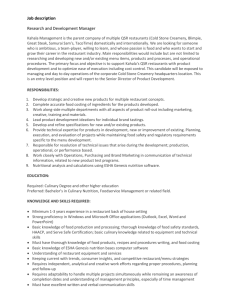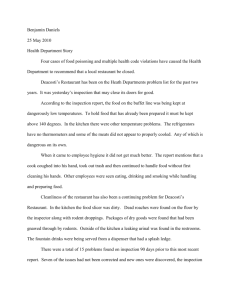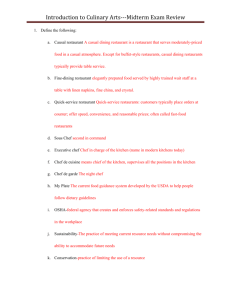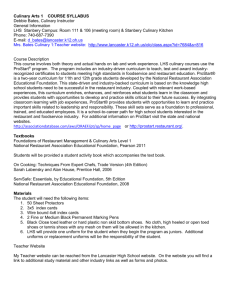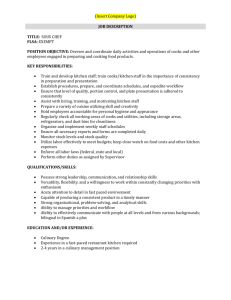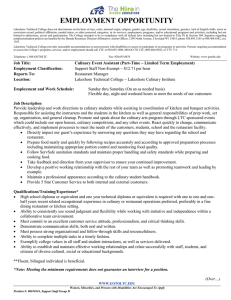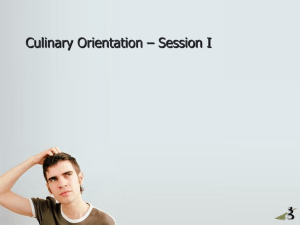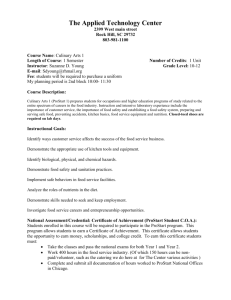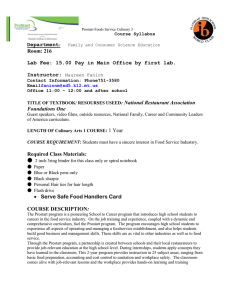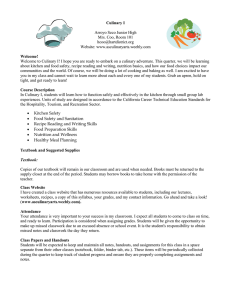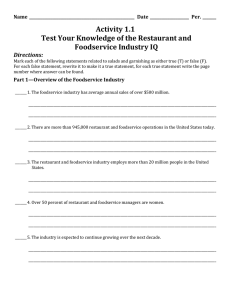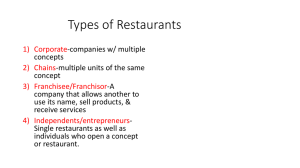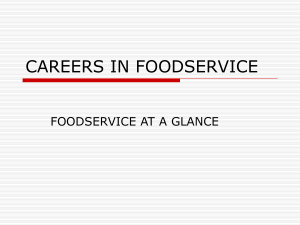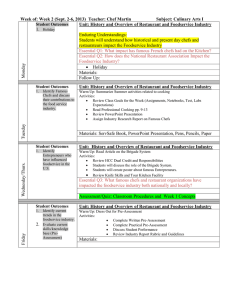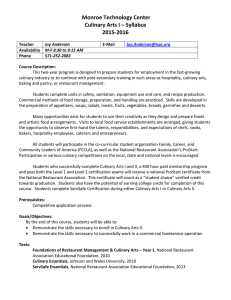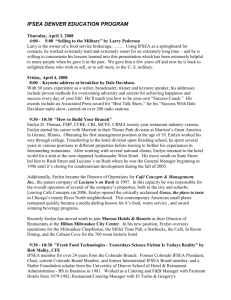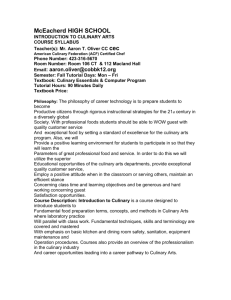Name Date Period ______ ProStart Chapter 1
advertisement
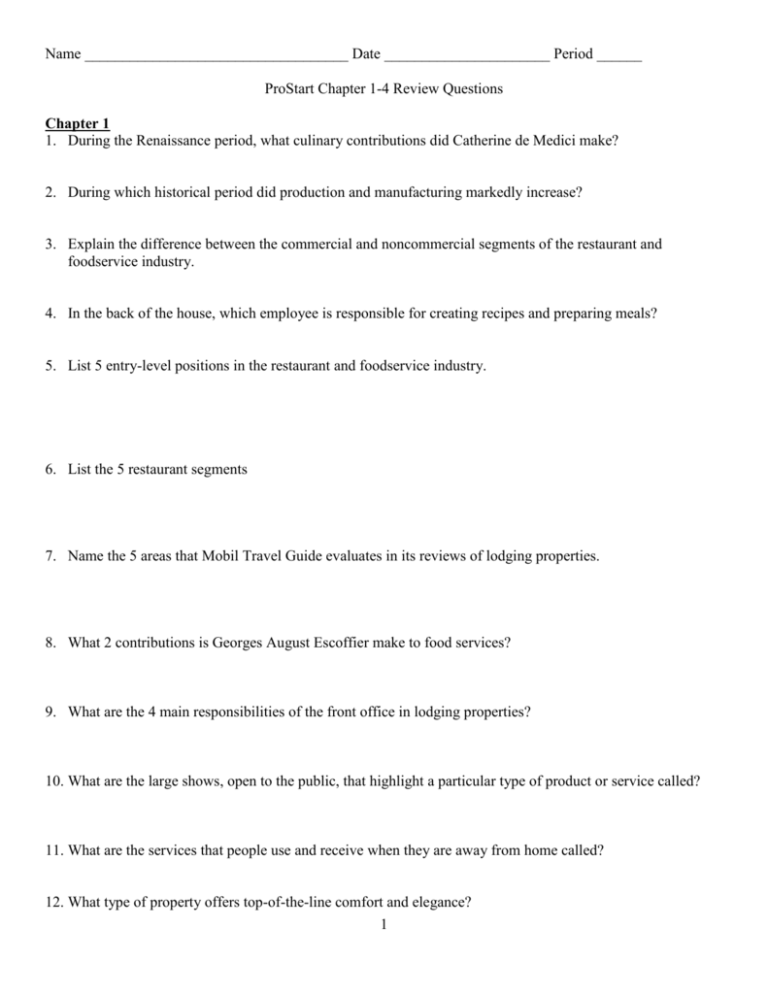
Name ___________________________________ Date ______________________ Period ______ ProStart Chapter 1-4 Review Questions Chapter 1 1. During the Renaissance period, what culinary contributions did Catherine de Medici make? 2. During which historical period did production and manufacturing markedly increase? 3. Explain the difference between the commercial and noncommercial segments of the restaurant and foodservice industry. 4. In the back of the house, which employee is responsible for creating recipes and preparing meals? 5. List 5 entry-level positions in the restaurant and foodservice industry. 6. List the 5 restaurant segments 7. Name the 5 areas that Mobil Travel Guide evaluates in its reviews of lodging properties. 8. What 2 contributions is Georges August Escoffier make to food services? 9. What are the 4 main responsibilities of the front office in lodging properties? 10. What are the large shows, open to the public, that highlight a particular type of product or service called? 11. What are the services that people use and receive when they are away from home called? 12. What type of property offers top-of-the-line comfort and elegance? 1 13. What type of tourism includes visiting a place to enjoy its natural beauty? 14. What were the private clubs that offered food to members in ancient Greece called? 15. Who defined the art of grand cuisine? 16. Who is the highest-ranking member of a culinary team? 17. Who wrote one of the earliest known cookbooks, De Re Coquinaria (On Cooking)? Chapter 2 1. A whole chicken must be cooked to what minimum internal temperature? 2. List 4 ways to prevent cross-contamination. 3. List the required minimum internal cooking temperature for beef roasts, stuffed pork chops, and shell eggs for immediate service. 4. Most bacteria can be controlled by following this food safety practice. 5. Name 2 instances when foodhandlers must change their gloves. 6. Name 3 symptoms that require a foodhandler to stay home from work. 7. Name a hand care practice, in addition to handwashing, that can prevent contamination. 8. Name the 2 requirements for a supplier to be considered an approved supplier. 9. Name the 6 conditions that favor the growth of most foodborne pathogens. 10. Once soap has been applied, how long should foodhandlers scrub hands and arms? 2 11. The 4 types of pathogens that can contaminate food and cause foodborne illness are viruses, bacteria, fungi, and _____ 12. What are the 4 acceptable methods for thawing TCS food? 13. What are the 7 HACCP principals? 14. What are the best ways to prevent the spread of viruses? 15. What are the temperature requirements for receiving shell eggs and milk products? 16. What are the time and temperature requirements for reheating beef stew that will be held for service? 17. Which temperature probe is used to check the internal temperature of thin foods? Chapter 3 1. A Class A fire extinguisher is used for what type of flammable material(s)? 2. List the 4 general areas that are covered in a safety audit. 3. Name 3 sharp hazards that are found in the professional kitchen. 4. Name the treatment given to an injured person for light injuries or until emergency service can provide more complete treatment. 3 5. On which types of surfaces do the most common slips, trips, and falls occur? 6. The malicious and deliberate burning of property is called what? 7. Water-based extinguishers are used for which class of fire? 8. What degree of burn is most serious? 9. What does CPR stand for? 10. What is the name of the federal agency that creates and enforces safety-related standards and regulations in the workplace? 11. What is the PASS system? 12. What is the proper way to pass a knife to another person? 13. What is the purpose of an emergency plan? 14. What procedure would you use to remove food or other obstacles from the airway of a choking person? 15. What should restaurant and foodservice operations do if liquid is spilled while customers are in the area of the spill? 16. Which document describes the hazards of the chemicals in a restaurant or foodservice operation? 17. Which type of detector uses infrared and ultraviolet sensors that respond to the movement of flame, or to its radiant energy? Chapter 4 1. Before a dish is sent out of the kitchen, what does a culinary professional do? 4 2. How many ounces are in one cup? 3. If 60 of 180 people in a restaurant have ordered the house special, then what percentage of customers have ordered the house special? 4. In a traditional dining room brigade, who is responsible for explaining the menu to guests and taking their orders? 5. In which section of the kitchen is salad preparation performed? 6. List 4 attributes of a culinary professional. 7. List the 4 groups to whom a professional is responsible. 8. Using the kitchen brigade system, who is responsible for accepting orders from the dining room and reviewing dishes before service? 9. What are the 2 major issues in determining the number of workstations in a kitchen? 10. What information is included in a standardized recipe? 11. What is someone who has studied and continues to study the art of cooking called? 12. What is the amount left after vegetables have been trimmed and cut before being used in recipes called? 13. What is the formula for converting Fahrenheit to Celsius? 14. What is the number of servings or the amount the recipe makes called? 15. What is the temperature at which water boils? 16. Which method for measuring fat involves packing the fat down into the cup and pressing firmly to remove air bubbles? 5
